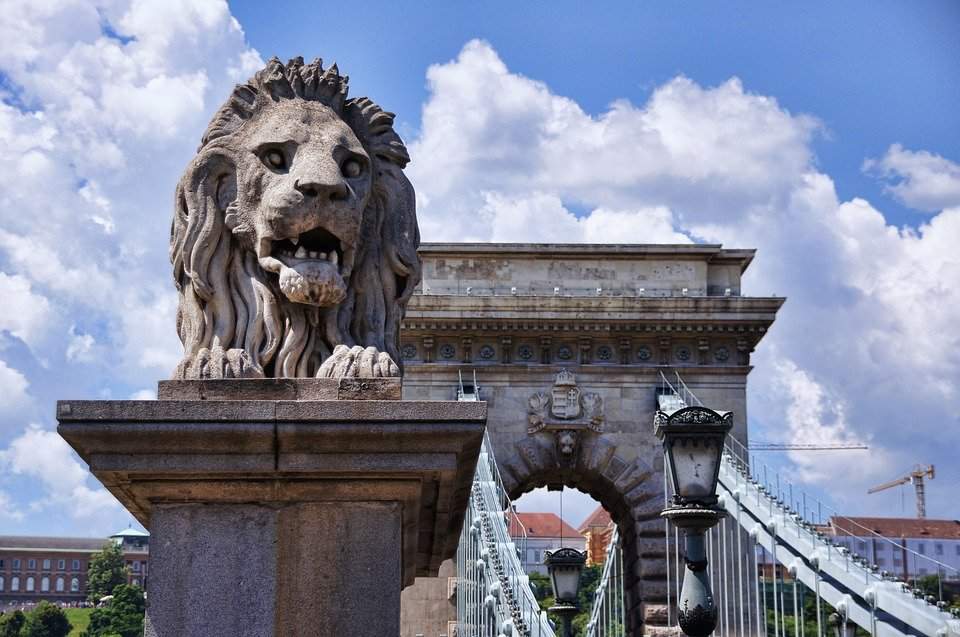The legend about the stone lions of the iconic Chain Bridge
Magyarorszagkul.nlcafe.hu reports that there is a legend about the stone lions sitting on either sides of the Chain Bridge that says that the lions do not have a tongue because the sculptor forgot to create it for them. The myth goes on by saying that when this rumor got unfolded, the whole country made fun of him and being ashamed, he committed suicide by jumping into the Danube from the bridge. Let’s see what is the truth is.
The Chain Bridge

First of all, let’s check out some facts about the Chain Bridge itself. The Chain Bridge was the idea of István Széchenyi and it was also thanks to him, that the bridge was finally constructed. It was him who got the architects for the project and it was also him who financed the construction and convinced the general public about the need for such a bridge. The construction started in 1839 and the bridge was finished in November 1849, a little after the execution of the 13 martyrs of Arad. It was inaugurated by Haynau and thus, the atmosphere was not the best at the ceremony. Only the soldiers drew up and a handful of passers-by participated in it.
Furthermore, Széchenyi was not present either, because at that time he was treated at the Mental Insitution in Döbling, as his vision about the death of the nation and his own pang of conscience consumed him, and thus he became a broken man.
As far as the lions are concerned, they were placed on either side of the bridge in 1852. The sculptor, János Marschalkó was satisfied with his work until Jakab Frick, a shoemaker apprentice cried out loudly that the lions have no tongue.

wikicommons by Gyurika
About the rumor
The rumor dispersed very quickly and after some time, the whole city gossiped about the fact that the sculptor forgot to create the tongues for the lions.
The response of the sculptor was that in fact, he created the tongues, but they were deliberately made invisible and consequently, if a passers-by takes a look at the lions, she cannot see the tongues in their mouth.
To prove his truth, Marschalkó went with his friends to see a real lion. At that time, only the “travelling zoos” arriving to towns could give the opportunity to marvel at these animals. These were the predecessors of today’s zoos, but those also offered small performances. The rumor goes on that after the sculptor and his friends saw a real lion, they became convinced that the sculptor master was right.

fortepan.hu
Despite this, the rumor did not stop. Marschalkó, who had also worked on the Cathedral of Kassa, on the church of Fót and on the sculptures of the MTA, the Vigadó and the Rudas Thermal Bath, was very much annoyed by this news and by the fact, that despite his many works, his name was only remembered for by this legend. He responded with an ironic answer by saying:
“Would that your wife had such a tongue as my lions!”
So, what happened to Marschalkó? He did not commit suicide as the legend holds, but died of old age at 59.
The moral of the legend
If we believe in what the sculptor said, then the lions have tongues but they are invisible from the ground, and if we want to gather evidence, we might decide to witness it with our own eyes. But in that case, we should mount on the statues, and that’s not an easy task to do.
Photos: pixabay.com; commons.wikimedia.org; fortepan.hu
Source: http://magyarorszagkul.nlcafe.hu
please make a donation here
Hot news
What happened today in Hungary? — 24 April, 2024
Hungarian minister Nagy: Brussels keeps the agriculture crisis going
Primark to open its first store in Hungary soon!
Orbán promises everyone profession and decent pay
Wolt in Hungary exposed: Is the food delivery sector really filled with guest workers?
Ruling Fidesz is afraid of a migration wave towards Europe


